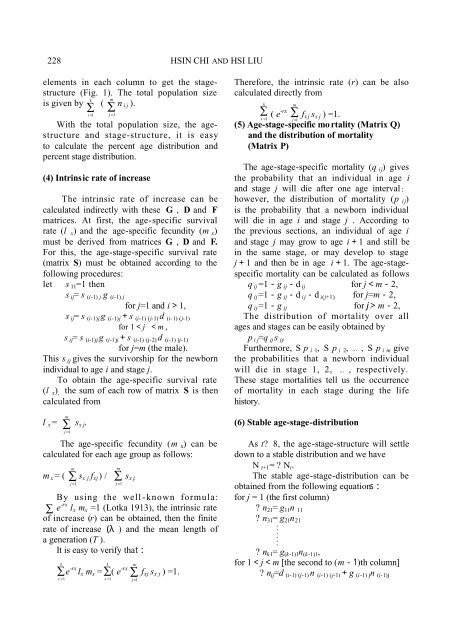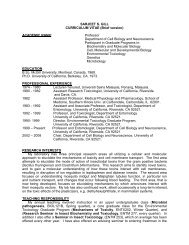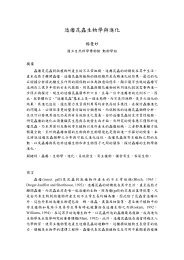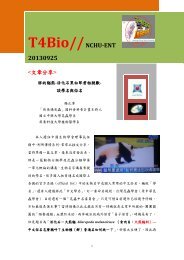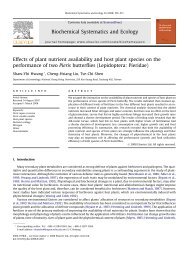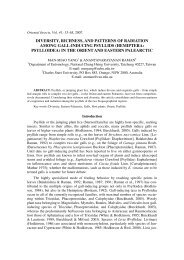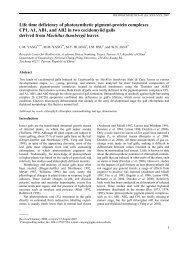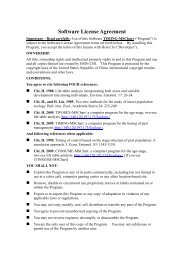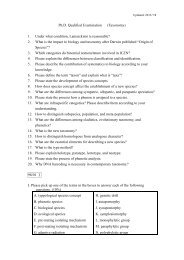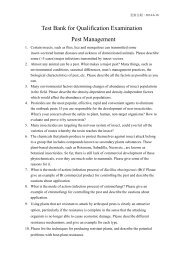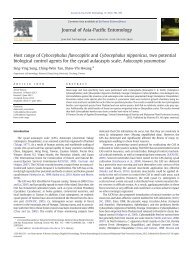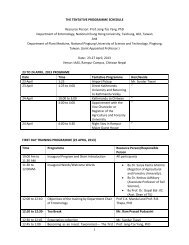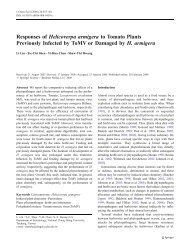Chi, H., and H. Liu. 1985. Two new methods for the study of insect ...
Chi, H., and H. Liu. 1985. Two new methods for the study of insect ...
Chi, H., and H. Liu. 1985. Two new methods for the study of insect ...
You also want an ePaper? Increase the reach of your titles
YUMPU automatically turns print PDFs into web optimized ePapers that Google loves.
228 HSIN CHI AND HSI LIU<br />
elements in each column to get <strong>the</strong> stagestructure<br />
(Fig. 1). The total population size<br />
k m<br />
is given by ( n i j ).<br />
With <strong>the</strong> total population size, <strong>the</strong> agestructure<br />
<strong>and</strong> stage-structure, it is easy<br />
to calculate <strong>the</strong> percent age distribution <strong>and</strong><br />
percent stage distribution.<br />
(4) Intrinsic rate <strong>of</strong> increase<br />
The intrinsic rate <strong>of</strong> increase can be<br />
calculated indirectly with <strong>the</strong>se G , D <strong>and</strong> F<br />
matrices. At first, <strong>the</strong> age-specific survival<br />
rate (l x ) <strong>and</strong> <strong>the</strong> age-specific fecundity (m x)<br />
must be derived from matrices G , D <strong>and</strong> F.<br />
For this, <strong>the</strong> age-stage-specific survival rate<br />
(matrix S) must be obtained according to <strong>the</strong><br />
following procedures:<br />
let<br />
s 11=1 <strong>the</strong>n<br />
s ij= s (i-1) j g (i-1) j<br />
<strong>for</strong> j=1 <strong>and</strong> i1,<br />
s ij= s (i-1)j g (i-1)j s (i-1) (j-1) d (i-1) (j-1)<br />
<strong>for</strong> 1j m ,<br />
s ij= s (i-1)j g (i-1)j s (i-1) (j-2) d (i-1) (j-1)<br />
<strong>for</strong> j=m (<strong>the</strong> male).<br />
This s ij gives <strong>the</strong> survivorship <strong>for</strong> <strong>the</strong> <strong>new</strong>born<br />
individual to age i <strong>and</strong> stage j.<br />
To obtain <strong>the</strong> age-specific survival rate<br />
(l x ) , <strong>the</strong> sum <strong>of</strong> each row <strong>of</strong> matrix S is <strong>the</strong>n<br />
calculated from<br />
m<br />
∑<br />
l x = s x j .<br />
j=<br />
1<br />
∑<br />
i=<br />
1<br />
∑<br />
j=<br />
1<br />
The age-specific fecundity (m x) can be<br />
calculated <strong>for</strong> each age group as follows:<br />
m<br />
∑<br />
∑<br />
m x = ( s x j f xj ) / s x j.<br />
j=<br />
1<br />
m<br />
j=<br />
1<br />
By using <strong>the</strong> well-known <strong>for</strong>mula:<br />
∑ e -rx l x m x =1 (Lotka 1913), <strong>the</strong> intrinsic rate<br />
<strong>of</strong> increase (r) can be obtained, <strong>the</strong>n <strong>the</strong> finite<br />
rate <strong>of</strong> increase ) <strong>and</strong> <strong>the</strong> mean length <strong>of</strong><br />
a generation (T ).<br />
It is easy to verify tha <br />
k<br />
∑<br />
x = 1<br />
k<br />
∑<br />
e -rx l x m x = ( e -rx f xj s x j ) =1.<br />
x = 1<br />
m<br />
∑<br />
j=<br />
1<br />
There<strong>for</strong>e, <strong>the</strong> intrinsic rate (r) can be also<br />
calculated directly from<br />
k<br />
∑<br />
m<br />
∑<br />
( e -rx f xj s x j ) =1.<br />
x = 1<br />
j=<br />
1<br />
(5) Age-stage-specific mo rtality (Matrix Q)<br />
<strong>and</strong> <strong>the</strong> distribution <strong>of</strong> mortality<br />
(Matrix P)<br />
The age-stage-specific mortality (q ij) gives<br />
<strong>the</strong> probability that an individual in age i<br />
<strong>and</strong> stage j will die after one age interval<br />
however, <strong>the</strong> distribution <strong>of</strong> mortality (p ij)<br />
is <strong>the</strong> probability that a <strong>new</strong>born individual<br />
will die in age i <strong>and</strong> stage j . According to<br />
<strong>the</strong> previous sections, an individual <strong>of</strong> age i<br />
<strong>and</strong> stage j may grow to age i1 <strong>and</strong> still be<br />
in <strong>the</strong> same stage, or may develop to stage<br />
j1 <strong>and</strong> <strong>the</strong>n be in age i1. The age-stagespecific<br />
mortality can be calculated as follows<br />
q ij =1g ijd ij<br />
<strong>for</strong> jm2,<br />
q ij =1g ijd ijd i(j+1) <strong>for</strong> j=m2,<br />
q ij =1g ij<br />
<strong>for</strong> m2,<br />
The distribution <strong>of</strong> mortality over all<br />
ages <strong>and</strong> stages can be easily obtained by<br />
p i j=q ij s ij.<br />
Fur<strong>the</strong>rmore, S p i 1, S p i 2, …, S p i m give<br />
<strong>the</strong> probabilities that a <strong>new</strong>born individual<br />
will die in stage 1, 2, … , respectively.<br />
These stage mortalities tell us <strong>the</strong> occurrence<br />
<strong>of</strong> mortality in each stage during <strong>the</strong> life<br />
history.<br />
(6) Stable age-stage-distribution<br />
As t? 8, <strong>the</strong> age-stage-structure will settle<br />
down to a stable distribution <strong>and</strong> we have<br />
N t+1 = ? N t .<br />
The stable age-stage-distribution can be<br />
obtained from <strong>the</strong> following equation <br />
<strong>for</strong> j = 1 (<strong>the</strong> first column)<br />
? n 21 = g 11 n 11<br />
? n 31 = g 21 n 21<br />
.<br />
? n k1 = g (k-1)1 n (k-1)1 ,<br />
<strong>for</strong> 1jm [<strong>the</strong> second to (m)th column]<br />
? n ij =d (i-1) (j-1) n (i-1) (j-1) g (i-1) j n (i-1)j


